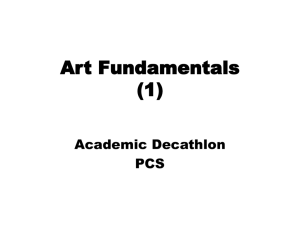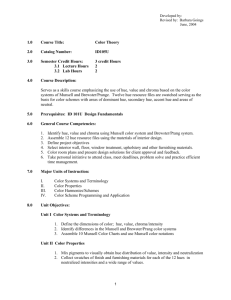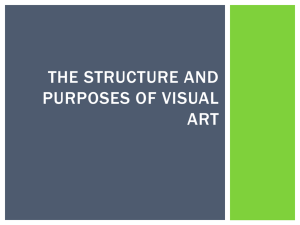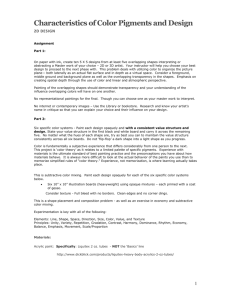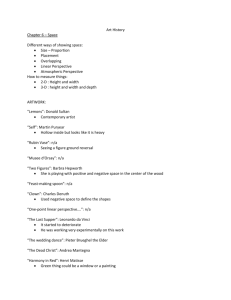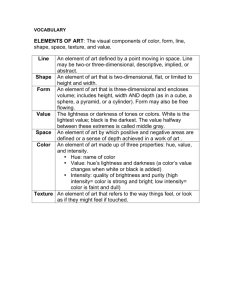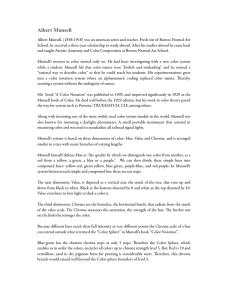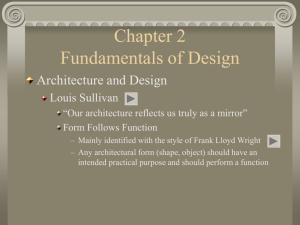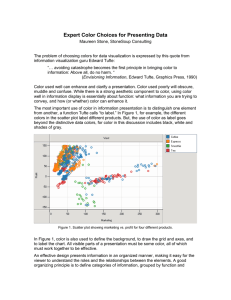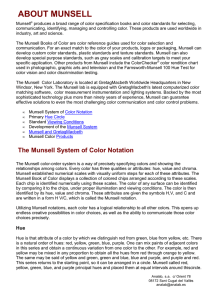The Munsell Color Tree Colors everywhere, but who can count them
advertisement
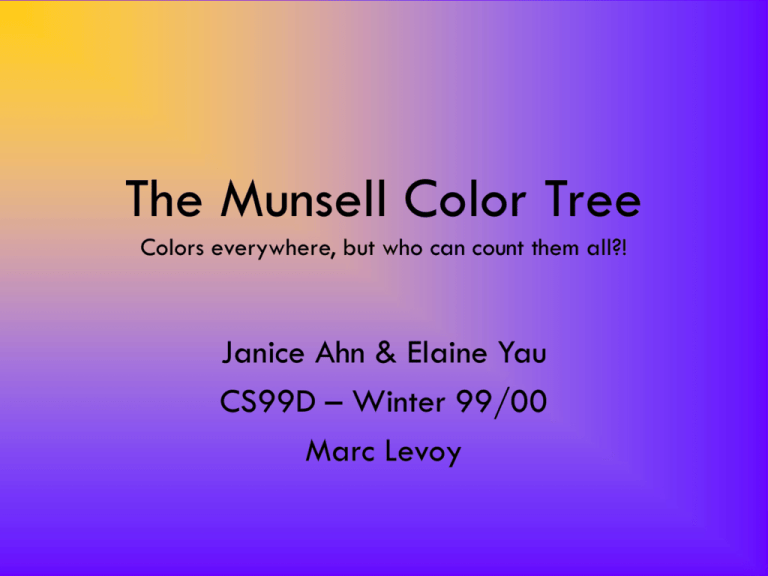
The Munsell Color Tree Colors everywhere, but who can count them all?! Janice Ahn & Elaine Yau CS99D – Winter 99/00 Marc Levoy Historical Problems with Identifying Colors • Theoretical Problems – Numerous color concepts – Different theorists organize properties of color into different functional systems • Leonardo da Vinci (15th Century) • Newton – discovered spectrum and devised color circle • J.C. Le Blon – observed primary nature of red, yellow, blue and described hues from mixing (1756) • Moses Harris – published first color circle in full color (1766) Different Color Wheels • Color wheel 1 Historical Problems with Identifying Colors • Practical Problems – Individual color vocabulary • Breadth • Definitions/associations – Trade names and commercial naming • Behr Paints Various Color Classifications Munsell Solves Color Problems! • Albert H. Munsell – Seascape painter of the 1890s – Munsell System of Color Notation (1905) – One of the color standards used by the US National Bureau of Standards – Used in science, industry, and art • Soil samples What is the Munsell Color Tree? • 3D Spherical Model • Incorporates concepts of hue, value, and chroma in one model • Organized in a numerical classification system • Inclusive of all colors – each color has its own place How does it work? • Based on the 2D Color Wheel – Includes primary, secondary colors, i.e. hues – Can be expanded to include intermediary hues • Shows all variations of colors/hues, which are at full intensity on the wheel • Notation: 5.0 + letter 5.0 R = red 5.0 BG = blue green How does it work? • Value Scale – The lightness/darkness of a particular hue – Related to brightness, luminosity – Vertical arrangement: the “trunk” of the color tree • Nine levels of values – 1 = black – 9 = white – Notation: 5.0 R 5/ ; 5.0 BG 7/ • Values of hues are compared with this neutral gray pole How does it work? • Chroma – Refers to strength/weakness of a hue at a certain value – Related to purity, saturation, intensity – Horizontal arrangement: the branches of the tree • Fourteen levels of chromas – 1 = dullest, most gray variation of the hue – 14 = most intense, pure state of the hue – Notation: 5.0 R 5/6; 5.0 BG 7/8 (even numbers) – 5.0 R 5/12 is redder than 5.0 R 5/10 Value and Chroma To sum up… • Hue – purest form of a color – 5.0 R; 10.0 YRY – Leaves of the tree To sum up… • Hue – purest form of a color – 5.0 R; 10.0 YRY – Leaves of the tree • Value – placement along the gray scale – vertical axis (trunk) – 5.0 R 5/ To sum up… • Hue – purest form of a color – 5.0 R; 10.0 YRY – Leaves of the tree • Value – placement along the gray scale – vertical axis (trunk) – 5.0 R 5/ • Chroma – intensity of a hue – horizontal axis (branches) – 5.0 R 5/14 (most intense red) To sum up… • Hue – purest form of a color – 5.0 R; 10.0 YRY – Leaves of the tree • Value – placement along the gray scale – vertical axis (trunk) – 5.0 R 5/ • Chroma – intensity of a hue – horizontal axis (branches) – 5.0 R 5/14 (most intense red) Each hue has it’s own page on the tree • Each hue chart also has different # of chips depending on the chroma possibilities of each hue at value levels Making our Munsell Color Tree Obstacles • Sorting through vast pool of color chips ~1500 at Home Depot (we got lost getting there, too) • Taunts from the Home Depot Staff • Eyestrain and bodily fatigue from constant visual comparisons and matching, and fluorescent lighting • Limited spectrum of Behr color palette – Resulted in several empty slots Making our Munsell Color Tree Choices • Construction/Display of our Color Tree – Wanted: 3-dimensional, rotating pages, upright • Black background to emphasize color contrasts • Shortened chroma range on each page – Eliminated 1 – gray tone – Eliminated 14 – most hues do not reach this intensity, only red Color in Art Mark Rothko (1956) Orange and Yellow Rothko (1954) Red, Orange, Tan, and Purple Henri Matisse (1943-44) Icarus (Jazz) Summer (1890) Thomas Wilmer Dewing Josef Albers (1966) White Line Square XIII Piet Mondrian (1922) Composition with Blue, Yellow, Black, and Red Marc Chagall (1913) Paris Through My Window The End If we have time… And since we have time… Bibliography Birren, Faber. Principles of Color. NY: Van Nostrand Reinhold Co., 1969. Color Matters. http://www.colormatters.com. March 2000. Color Theory. http://www.busybrushes.com/Classroom/colorelem.html. March 2000. Leland, Nita. Exploring Color. OH: North Light Publishers, 1985. Parramon, Jose M. The Book of Color. NY: Watson-Guptill Publications, 1993. Sidelinger, Stephen J. Color Manual. New Jersey: Prentice-Hall, Inc., 1985. National Gallery of Art. http://www.nga.gov/home.htm. March, 2000. Artcyclopedia. www.artcyclopedia.com. March, 2000.
